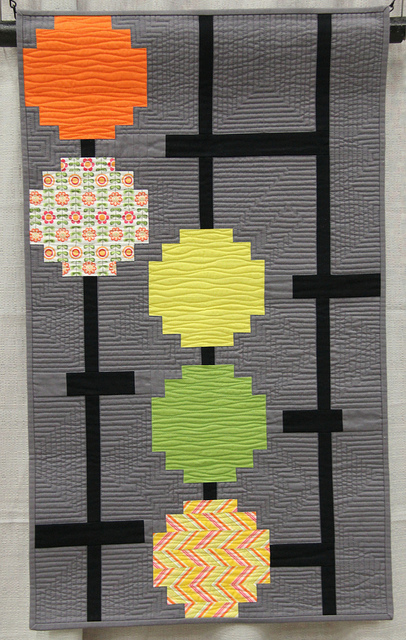When I noticed that 2 of my favorite 11 quilts at AQS-Charlotte were by Jean Larson, I knew I had to meet her. Luckily, while I was trying to figure out how to contact her, she contacted me! Jean has lived in Chattanooga since the early 1970s, so we met at AQS-Chattanooga.
First, as a refresher, here are the two quilts that attracted my attention at AQS-Charlotte:

This quilt by Jean Larson won the Original Design award in the Modern Quilt Challenge! The Modern Quilt Challenge exhibit was on display at AQS Charlotte as well as other shows during the year.
Jean entered a different, and maybe even more interesting, quilt in AQS-Chattanooga:
There are so many things to see in this simple quilt! First, the design is tessellated! Jean is a mathematician by training, so she explained it to me, but I’m going to have to ask her to write a guest post to explain it to you. More on that later.
Second, those variations in yellow are for real, not just trouble with exposure on my camera 😉 The two yellows add complexity to the quilt. And finally, although I couldn’t see it until she pointed it out, this quilt is actually a grid of squares in alternating colors:
Look at the quilting, too!
So, here’s a little bit about Jean:
She’s had several starts at quilting. Her first quilt, in 1976, was a traditional log cabin made with the quilt-as-you-go method and using poly-cotton fabrics, which were about all that was available at the time. Her second, in 1984, was an orange and turquoise quilt that she worked on while potty training her two adopted boys! She began quilting seriously in the late ’90s. In 2012 she discovered modern quilting through a neighbor, and she hasn’t looked back since. She’s an active member of the Chattanooga Modern Quilt Guild and apparently knows everybody–numerous people stopped to chat with her while we were talking about quilts at the AQS show. She had a quilt accepted for the first QuiltCon in 2013, and it has been published several places as an example of good use of negative space. Here it is:
Jean says she likes simplicity and alternative grid work in quilts. She is inspired by geometric shapes and by fabrics–especially stripes. She loves the mathematics of tessellations and plans to make more tessellated quilts. I look forward to seeing them!
And I’m going to beg her to write a guest article on tessellations for my next design-your-own-quilt post. If you know Jean, encourage her to do it!

























